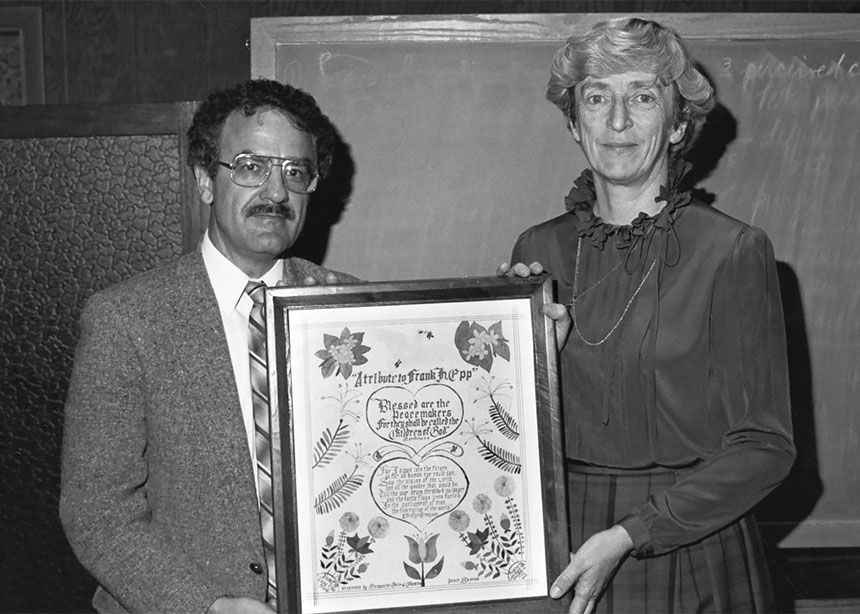In 1841, Ontario Mennonite bishop Benjamin Eby wrote that the time would come “when all Christians, and indeed all governmental authorities, will acknowledge that the waging of war is evil and does not belong in the kingdom of God.”
Eby’s words echoed Psalm 46, which says, “Come, behold the works of the Lord. . . . God makes wars cease to the end of the earth; God breaks the bow, and shatters the spear, and burns the chariots with fire.”
It took two world wars and 100 years after Eby’s statement before Mennonites launched a vigorous witness for peace. Building on previous work on peace and conscientious objection, Mennonite Central Committee (MCC) established its Peace Section in 1942. The U.S.-based Peace Section’s mandate was to address “all matters that concerned witness to the nonresistant way of life.”
This was a key development in Mennonite peace witness. The Peace Section worked cooperatively with Mennonite conference peace committees, Mennonite academic institutions and mission agencies. There were occasional bursts of cooperation with Quakers and Brethren churches.
Military conscription was a central issue in the early years. Feeling chastened by the lack of preparation in the churches before World War I, Canadian and American peace church leaders appealed to their governments for exemption from military service. President Roosevelt signed Conscientious Objector (CO) provisions into law in September of 1940. The Canadian government passed an Order in Council in 1940 that required alternate service for COs, building on previous CO provisions.
For decades, distinguished church leaders in Canada and the U.S. had brought the full denominational weight to bear in opposition to the authority of the state to conscript its citizens into military service.
In her 2013 history of MCC in Canada, Esther Epp-Tiessen reported that 10,851 men spent time in alternative service in Canada during World War II. Of those, 7,500 were Mennonite. In the U.S., 4,665 Mennonites were among the 12,600 COs.
While the MCC Peace Section was based in the U.S., Canadians were involved with it from the beginning. Forms of MCC work on peace in Canada evolved over time. In 1973, MCC Canada strengthened its peace education and advocacy work by establishing a Canadian Peace and Social Concerns Committee with a broad set of “Guiding Principles.” Approved in 1975, these principles referred to “1) war and revolution, 2) industrial relations, 3) church and state relations, 4) race relations, 5) international affairs, 6) capital punishment and penal reform, 7) problems of urbanization, 8) poverty and affluence, 9) role of women. . . .”
In 1974–75, a bi-national Peace Section was formed, with Canadian and American membership, to focus on a shared international peace and justice agenda. This entity worked together congenially with the U.S. Peace Section and the Canadian Peace and Social Concerns Committee.
Peace Section work carried out by Canadians over the years included work related to Vietnam, apartheid in South Africa, Palestine-Israel, and various publications.
A document titled “The Progressions of Mennonite Central Committee Peace Section, 1984” speaks of the evolution of MCC peace work:
“Over four decades ago, the overriding concern was to prevent Mennonite boys from going to war; today the agenda is to prevent the whole world from going to war. . . . Thus, the history of the Peace Section can be viewed as a series of progressions, that reflect the expanding circles of peace, pointing toward the new Jerusalem where nations will not learn to make war anymore, and toward the new earth and the new heaven in which righteousness dwells.”
After a half century, much of the Peace Section’s work was absorbed into other MCC programs.







Leave a Reply
You must be logged in to post a comment.